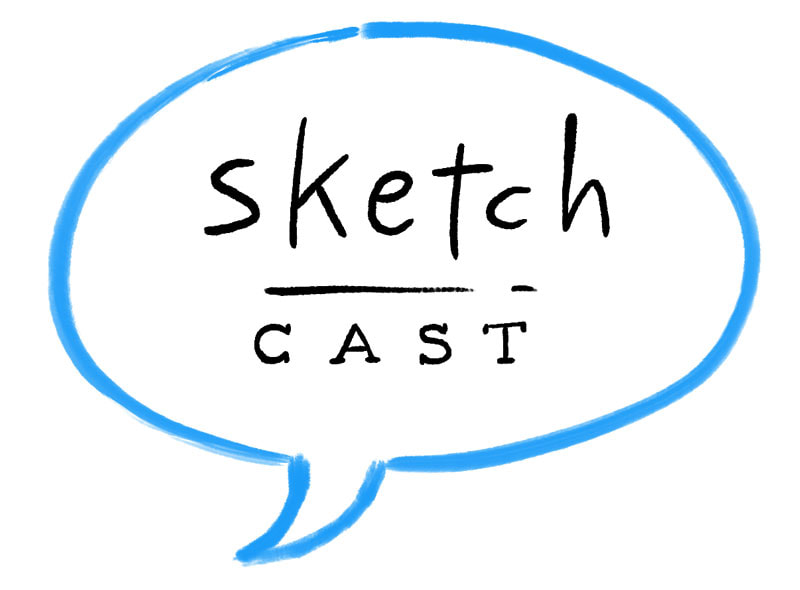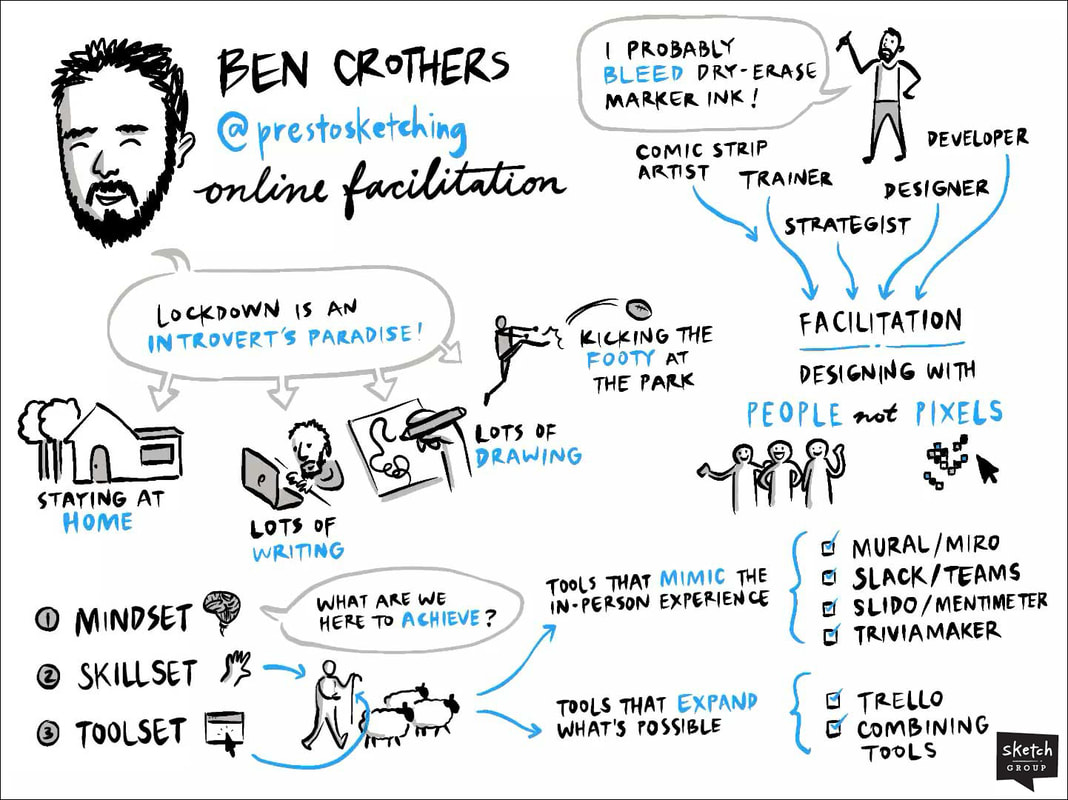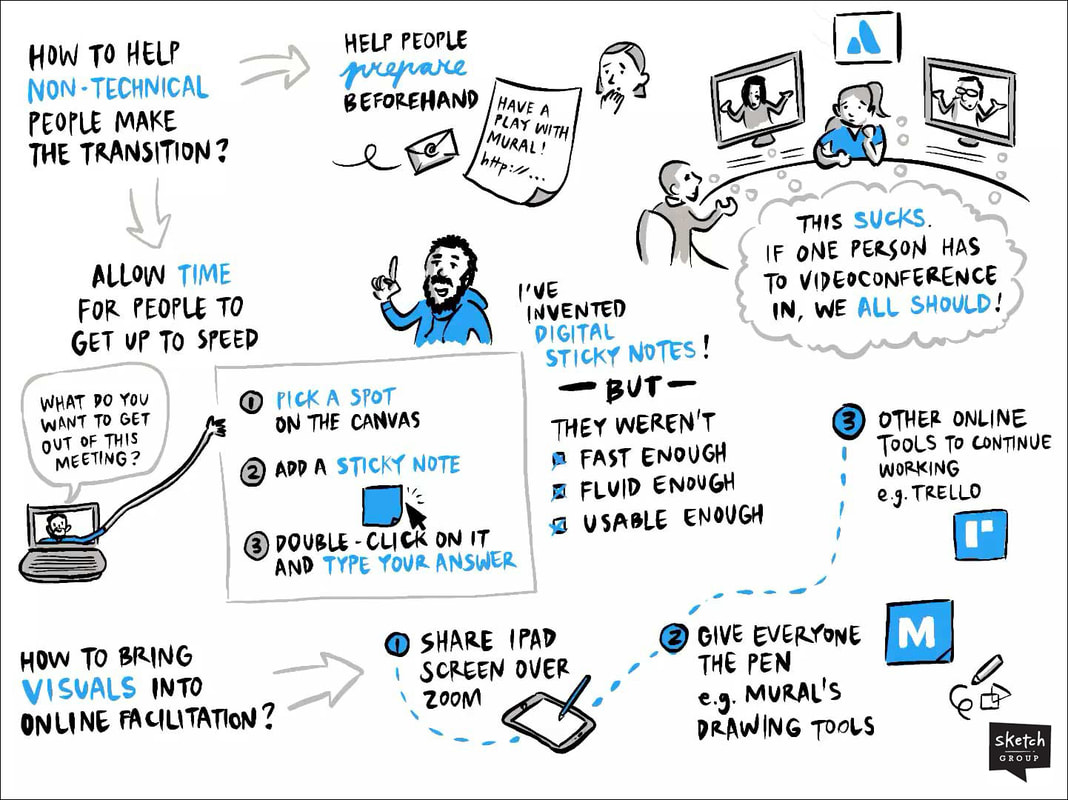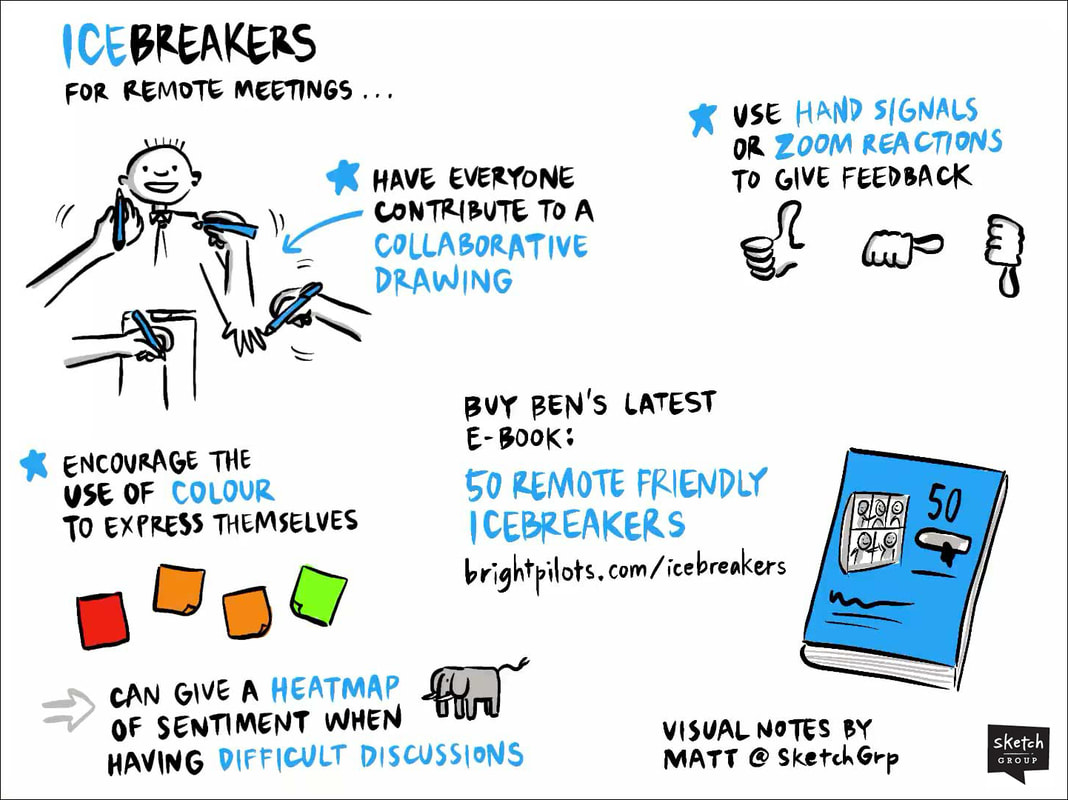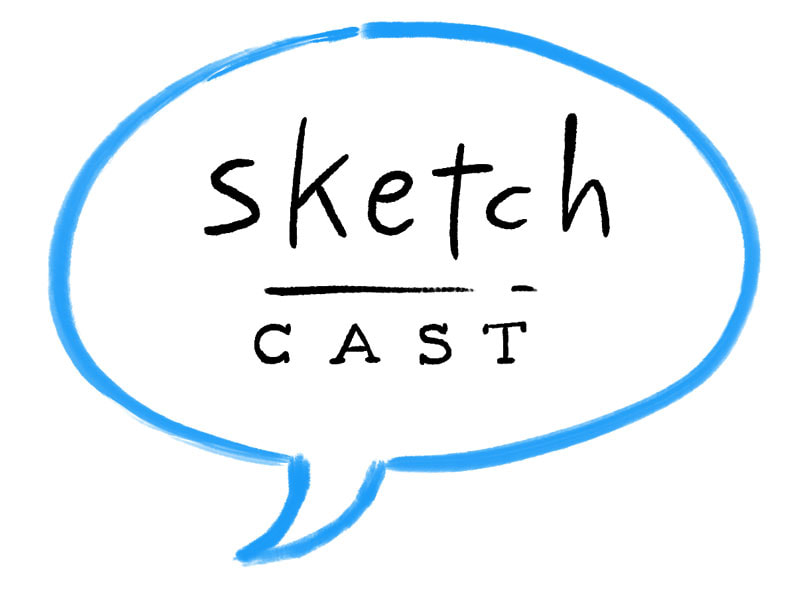
I’m super excited to announce a new project that we’ve been working on here at Sketch Group: The Sketchcast
The Sketchcast is a show that teaches you how to use sketching and visuals to be amazing. I talk to interesting people to hear how they are using sketching to change the world.
The first episode, my interview with Ben Crothers about Online Facilitation, is up now on YouTube:
Ben is designer, strategist, facilitator, author, and all-round great guy, and we have a fantastic discussion abouthow to facilitate groups online. We discuss, among other things:
- how you can use colour to help people to express themselves better
- how you can help people get up to speed on digital tools when they’ve never used them before, and
- Ben shares the specific tools that he’s using to do this kind of work
I know that lots of people like to listen to podcasts while driving or exercising (as audio only), so I’ve made an audio-only version available below (minus the visual notes and bloopers). Once we’ve published a few episodes, we’ll be sure to add The Sketchcast to the various podcasting platforms, but hopefully the SoundCloud file below will suffice for now.And because I know that consuming information in text format is sometimes more useful than in or audio or visual format, I’ve included a full transcript below.
I’m excited about the potential that this show has to help us further our cause here at Sketch Group—the belief that sketching can be transformational in people’s lives.
Give the show a watch/listen/read and let me know what you think in the comments below. I also welcome suggestions for future guests!
Tools and websites mentioned in the show:
- Mural
- Miro
- Slido
- TriviaMaker
- Mentimeter
- Bright Pilots – Ben’s visual facilitation business
- 50 Remote Friendly Icebreakers – Ben’s new ebook/website
Visual notes of the interview:
Full transcript:
Matt:
Welcome Ben Crothers.
Ben:
G’day mate, how are you?
Matt:
I’m great. So it is May, 2020.
Ben
It is.
Matt:
We are currently in stage three restrictions lockdown, as is much of the world. Which means we can’t go to a pub, we can’t eat out at restaurants, our kids are working from home instead of school. And lots of people have been impacted in a massive way. How are you faring, and what are you doing to stay sane in these crazy times?
Ben:
In these crazy, crazy times. Look, in some ways I feel I’m cheating a bit. This is an introvert’s paradise, right? I just get to sit at home, I get to draw, I get to write. This is fantastic and I’m saving an absolute motza in public transport. And I’m also very fortunate to have a really nice house and a lovely backyard. I’ve got local shops, I’ve got a fantastic park nearby to go and kick the footy. So, in a lot of ways it’s really, really nice. But you’re right, there are crazy times. And I have been getting cabin fever a bit. I’ve got two kids and they’ve certainly been doing school at home.
Ben:
Thankfully, they’re both in high school and they just stick to the regular timetable. So, it’s nice that they’ve got that structure. That’s nice for all of us and all of our sanities.
Matt:
Yeah.
Ben:
But honestly, I’ve just got to make sure that I make time to get out of the house, and go and kick a footy around, and go for a run, have a stretch. Because otherwise hours can go pass and I’m stuck at the same desk in yet another Zoom meeting. Yeah, that’s the main thing.
Matt:
Yeah. I’m realising that I’m much more of an introvert than I thought I was. I think a lot of people might be surprised to hear that, because I’m known amongst friends as being quite outgoing and talkative and gregarious. And I’m a bit like you, I’m happily playing a lot of guitar, and doing a bit of drawing and reading and meditation and exercise in the gym in the shed, and I’m quite happy. But I’m conscious that not everyone can spend that time on their own and they need the social interactions and they’re missing it.
Ben:
True.
Matt:
So, anyway, I’m glad that you’re coping as well as can be expected. So, before there’s a ton of stuff that I want to ask you, but for our listeners, can you tell us your story about how you got to where you are now?
Ben:
Yeah, sure. Well, my name is Ben Crothers and I’m primarily a designer, a strategist, and a facilitator. And I do like drawing a lot. I probably bleed dry-erase marker ink. I love being at the whiteboard. And I guess I’ve been in the digital game scene, so probably the mid-nineties. So, this is back when putting, “under construction,” animated gif on some websites was the sensible thing to do. Can you believe it? That’s what we all thought. This is back in the days of Netscape Navigator and Geo CDs. If you remember Geo CDs. And I know there were crazy, crazy days and that’s how I first really got into digital.
Ben:
I had done some design prior to that in print design, but it was actually years that would go by before I would actually call myself a designer for some strange reason. I think I had a big inferiority complex about design. And funnily enough at the time I was also doing a lot of in-house training, like in different computer software applications and proprietary software. And so it was through classroom training that I think I actually started cutting my teeth as a facilitator.
Ben:
Just developing those skills as far as reading the room, setting up the scaffold so people could interact with each other and learn and really get something out of that session together. And through the years I’ve just done a mix of working at different agencies, and startups, and governments, and consultancies, and all sorts of clients and projects that have always involved facilitation in some way. And definitely a lot of design and these days I like to say, “I definitely design more with people rather than pixels.” I’m often designing how people work, how teams are brought together, what are the work patterns that they use? And so designing that experience, meeting by meeting, workshop by workshop, that’s a lot of what I’m into now.
Matt:
I think a lot of people might be surprised to hear you describe that background. You’re the author of a handful of books that are largely about sketching. And I think a lot of people assume that you’re an artist who has found their way to make your art a part of work. But it sounds like it’s been a bit more the other way round. Is that fair?
Ben:
That’s interesting. Yeah. I guess drawing, in general, has always been there. It’s always been there. Even back when I was at high school, I had a bunch of mates, actually I don’t think anyone knows this. I had a bunch of nerdy mates and of course we would deface every single textbook by drawing those little pictures in the corners of textbooks. And then you thumb in the corner to make animated pictures. I used to love that. We did that a lot. And I used to draw a lot of comics. I was moonlighting as a comic strip artist for a while as well. And when I got into design proper, because comic strips came so easily to me, I found myself storyboarding a lot. And whenever I wanted to explain a new idea, whenever I wanted to sort of show a new product or a new service in use, I would do a storyboard.
Ben:
And people would say, “Hey, wow, that’s fantastic. I can now really see how this is coming to life.” And I thought, “Oh, I’m onto something here.” And then I was regularly storyboarding. I remember being at a conference, I think it was in 2009 and there was a bloke next to me who was sketchnoting because back then we didn’t call it sketchnoting. I don’t think we called it anything, but I looked at that and then a massive light went on in my head and I was talking to him.
Ben:
And from that point on from 2009 onwards, I thought, “Oh, this is a thing that I can do more regularly. It has more form, it has more structure.” And from that point I started doing these sort of quick economical, explanatory kind of drawings in all of the workshops that I was running as well as in my notebook. And so yeah, that’s a long way of saying drawing has always been there in some form or another.
Matt:
Yeah. Great. So, I want to talk to you today about online facilitation, primarily. Largely, because I know a lot of facilitators who have been thrown a curveball because they don’t feel like they’re digital natives or they can take the leap to the online world. And they don’t know how to take their activities and the things that they’re used to doing in the room, into an online environment. So, can you share with me your experiences and the tools that you use and how you manage that space?
Ben:
Yeah. And you’re right, look, it is a really interesting space and it’s something that we’ve been thrust into, which I think is an ultimately positive thing. And for me, it’s been like design. I always think of facilitation the same as design in terms of mindset, skillset, and tool set. And no matter of what tool set you’re using, there’s always a mindset that has to come first. And as a facilitator, it’s always this art and science of trying to make sure everyone is really clear on that outcome of the meeting, like what are we all there to do? And your job as a facilitator then is to shift that along, and to make sure that everyone kind of realizes, move by move, how to kind of go from step one all the way around up to the very end.
Ben:
Whether it’s a big decision to be made, or a final idea to land on, or a unique value proposition, or a bunch of goals that then have to go into a project plan. Whatever it is, there’s a structure that you have to realize you need in place for people to understand this kind of progression move by move. And the way you do that, that’s where the skillset and tool set comes in. And yeah, you’re right.
Ben:
As we’re seeing, since we’re all online now, the tool set is definitely much different. And for me, it breaks down into two big camps. There’s the digital tools that mimic the real world, and I’m sure we’ll get into talking more about tools, but there’s those tools that act like a digital canvas with digital sticky notes. So, they’re kind of aping the real world. That’s great, but there’s also the other side which is really trying to make use of the advantages that digital gives us. And by that I mean we can actually have more people in the room, not just what can physically be accommodated in a physical room, and things like that.
Matt:
Okay. Let’s talk about some specifics. What are your favorite tools for each of those camps? What are you using at the moment?
Ben:
Yeah, definitely Mural and Miro, I tend to use Mural the most. Mural I think has been around for years and years now. It’s a digital canvas. It’s got loads and loads of different templates in it. It’s great because you can certainly use a lot of digital stickies and have many, many people all logged in, moving stuff around together. But it also has some simple drawing tools, that for me, I find really practical to be able to draw up different patterns and canvases. And there’s sort of basic visual patterns to help structure a conversation. So, it’s really good at that kind of thing. Miro is great, I think it used to be called Realtime Board. I’ve got a bit of a thing because I’m a bit of an artist and I’ve done art education and I almost have a soft spot for a lot of artists.
Ben:
I’ve always really liked the artist Miro. And to me it kind of makes me cringe when there’s software that’s named after an artist. But anyway, that’s a petty little thing. And that’s probably why I use Mural more than Miro. That’s great for I guess having a canvas to visually generate stuff and move stuff around. There’s certainly group chat like Slack and Microsoft Teams, so everyone can be in on the conversation at the same time. I’m also a big fan lately of software that lets you do polls and quizzes. Stuff where you can check for understanding. Things like slido.com. Have you heard of Slido?
Matt:
Yes.
Ben:
Slido’s great. Mentimeter. Just mentimeter.com, that’s great. And because I’ve been getting more into energizers and icebreakers lately just to try to make meetings more entertaining or engaging, I’ve been getting into more online trivia applications and websites. There’s a website called triviamaker.com. It’s got loads and loads of trivia games on there and it’s totally free, which is awesome. But you can also put in your own trivia games as well. That’s TriviaMaker. Yeah, those are the few that come to mind.
Matt:
Right, and so is that what you’re referring to when you say that these schools are not trying to replicate what you would normally do in the room, but they’re trying to take it beyond what’s possible?
Ben:
For me, all of those—apart from the quiz one—probably they’re all really replicating what we would normally do in the room.
Matt:
Right. And so what else is there that’s out there that can expand that?
Ben:
Good question. I think it really becomes, how you combine them. I think that’s where the digital experience starts to really be enhanced. By that I mean you can start a raw plan, if you like, with a group of people. You can have a structured conversation in something like Mural where you can say, “Okay, where are we now?” And you look at your strengths and opportunities and weaknesses and then you have a discussion about where you want to be. And you may want to kind of draw a metaphor of a mountain or a bridge or something like that.
Ben:
And then when it’s ready to go into the detail of how to get there, you can actually flip over to something like Trello and everyone can jump in and make a whole bunch of cards in the lists that Trello gives you. And that way they can even start assigning stuff to each other, or to people who aren’t even in the room. And the whole time they can also be interacting through group chat. They can be uploading and downloading files in group chat as well. So, I think the real magic comes in combining different tools together.
Matt:
Gotcha. And this is all in parallel with video conferencing software like Zoom or Teams or whatever, right?
Ben:
Absolutely. Yeah, that’s right. Actually, it’s funny, I’ve noticed recently in Zoom they now have little reactions. There’s a new reactions button that’s popped up in Zoom. I don’t know about yours, but at the moment mine just has a thumbs up and an applause emoji. And for a while now I’ve been using a deck of little cards and I’ve had a lot of success with those. And the cards themselves have things like emoji on them and definitely things like, “Yes, I agree.” You know those times when you’re in a meeting and there’s this heated agreement going on? People saying. “Yes, preach! That’s fantastic.”
Ben:
And there’s also the Elmo card, you know that one? E-L-M-O, enough, let’s move on. That’s a great card to wave. Of course, all of these things, you start to set up a bit of a social contract with. It’s something that is good to have an agreement at the beginning to say, “Look, when we meet online, there’s a whole lot of non-verbal communication that we miss out on because we’re not physically in the room.” It’s harder to pick up on all those non-verbal cues. And so having a cute little set of cards that you can flash out with different messages helps that and …
Matt:
Are you saying that having applause and thumbs up is limiting our ability to express ourselves?
Ben:
Well, I guess it’s a start. Yeah, and I dare say the hit prediction is that there’s going to be more reactions that come up in that little menu. There’s going to be other software as well, but those are obviously two common ones that Zoom have put in. But I reckon there’s going to be more to come. Yeah.
Matt:
It begs the question that adding more to tools can make them harder to use and there’s already a barrier to entry for people that aren’t as comfortable operating online. How do you go about getting people up to speed with tools like Mural if they’ve never used it before? Getting their head around the different options for, like, we had some technical difficulties getting our audio working before we started chatting today …
Ben:
We did.
Matt:
And both you and I have an IT background, right? So, how do we get people without that background up to speed? How do you tackle that?
Ben:
That’s a really important question, actually. A couple of ways spring to mind. One I suppose is trying to help people prepare beforehand. By that I mean I might send a link out to a Mural canvas within an email or something in a group chat that says, “Hey, please get acquainted with Mural,” or whatever it is, before the actual meeting, before the workshop. Because you’ll probably need to create a user account first. You’ll want to move a few things around, play with panning around the canvas, zooming in and out. I think panning and zooming are two things that people get stuck on. So, there’s that.
But people being people, we’re all busy. Often we get to a session and we haven’t done any of the preparation. And as a facilitator then you have to make sure that everyone has time to get acquainted.
Ben:
And one way I’ve found to be able to do that and it kind of kill several birds with one stone here. The very first activity I do is just ask a simple question like, “What’s one main thing you want to get out of this session?” Or “What’s one skill that you have that you really want to bring to bear today?” Or some kind of question that helps to oil up people’s brains. And then I’ll say, “Right, pick a spot on the canvas.” And here’s where I’ve prefabricated some text boxes and some stickies and I’ll say “Pick a spot and double click on the text box and write in there the answer to that question.” Or, “You might want to create a new sticky note. Use the menu on the side,” things like that and then, “Put your answer onto the canvas.” And so it’s just a way for them to ease into using the canvas.
Matt:
It’s like the tutorial at the start of a video game.
Ben:
Haha, yes. I’ve never thought about it that way. Yeah, that’s right. It’s like that Level One. It’s super, super easy. And you get that, “Ping, Tada. Here’s your first badge,” you unlock the first thing. Yeah. It’s exactly like that.
Matt:
Yeah, nice. So, how do you think that the availability of these online tools has shaped your style of facilitation?
Ben:
Gosh, that’s a good one. The availability. Well, I think in some ways I might’ve been a bit spoiled because for a lot of years I was working at an Australian software company called Atlassian. And like a lot of software companies, like a lot of companies maybe, we were very used to remote meetings, online meetings. We’re very used to, at least one person or a couple of people having to video conference in while the rest of us were in the room. It was always a bit of a hybrid. And because of that we always had to compensate—and I use that word with meaning—we had to compensate for having some people online and some people offline, like some people IRL, in real life. And what that meant was we had a mix of stuff on a whiteboard and stuff in Mural or Miro or stuff in Trello. And we were doing awkward things, like having to take photos of what was on a whiteboard and someone would take that from their phone and post it into the Slack channel and it was all very cumbersome.
Ben:
And then there was this massive watershed moment—there was this collective, “Aha,” that went throughout Atlassian—this was a while ago now—to say, “Look, it’s really a substandard experience for someone who’s videoconferencing in, trying to be a hundred percent involved with a bunch of people who are physically in a room.” And it was quite interesting, it all happened at once very quickly, where everyone said, “Okay, if one person is videoconferencing in, we all videoconference in.” And suddenly it wasn’t about compensating anymore. We had to make it work online. And once we had that force constraint that made us embrace the tools that were around at the time. I remember years ago, mate, years ago. I think you as well, maybe. I’ve been a coder from way back, when you’ve been in the digital game for as long as us, you have to do everything.
Ben:
You had to design it all, code it all front-end, back-end, you name it. And I remember years ago I actually coded up my own application to do digital sticky notes. And I thought it was great! I thought this thing was the greatest thing since sliced bread. And I thought I was really onto something. I’m going to make real, digital sticky notes around and you could type in them, and then you had to sort of click a button and it would commit it to the database and you could drag it around.
Ben:
Back then I thought that was fantastic, but looking back I can see it was just so cumbersome. It didn’t have that really light, fluid touch that you need for something like that to actually be practical. So, that’s why I didn’t end up using it for very long. But it’s really shown me how the digital tools have really had to accelerate. How well they have to be used. How practical they have to be, how fast they have to be. Yeah.
Matt:
Absolutely. As a former programmer who has worked with JavaScript, I can’t imagine the kinds of performance and interaction design challenges that the Mural team have had to solve to get that thing working like it does in the browser. I take my hat off, it’s massively impressive.
Ben:
Absolutely.
Matt:
So on this podcast we like to talk about visuals. And so how does, as a fellow visual thinker and someone who loves to express himself visually and teach others how to do the same, how do you bring visuals into your online facilitation moments?
Ben:
Yeah, great question. One really easy way, I guess, is drawing on my iPad and using Zoom at the same time. So, rather than just sharing what’s on my laptop screen, through the magic of Zoom and that lovely green share screen button you can actually choose to share an iPad screen via Airplay, I think it is. And so that way while I’m having a conversation, I can be drawing and everyone can see what I’m drawing. So, that’s as close as I can get to that fluid whiteboarding experience. Now the downside of that is it’s just me with the pen. There’s no one else with a pen. So, certainly for smaller meetings where it’s really about briefing and information-gathering and kicking around a problem, things like that, that works really nicely. I’m a big fan of that. Otherwise, I guess I’m really reaching for things like Mural where everyone has the pen in a way. Everyone can be contributing into that same canvas space. So that’s been a huge win for me.
Ben:
Actually, just a quick little story. I remember running a brand exploration workshop for a startup recently. And I had my lovely kind of structured set of templates and we moved through those and they had a wonderful time. It was really good, it was really productive, but the real magic came afterwards. They ended up inviting a couple more people into that canvas. And because they had already filled it all out, it had organized all the right information that, up until then, had been just scattered in different places in the organization and just hidden in different people’s brains. And there it all was, all lovely and laid out in a really visual map in this canvas in Mural. And then we had a designer and a content writer just coming of their own volition and add their own stuff and sought out some photos and a mood board, and it just took on a life of its own.
Ben:
And the guy rang me and he said, “Look, you’re not going to believe this. I thought that canvas was great before. You should see it now.” And they’ve really made it into something else, something far more creative and practical for them. So, I thought that was cool.
Matt:
Amazing.
Ben:
Yeah.
Matt:
And we were talking a little bit earlier about how people can use visuals to express themselves. Do you want to talk a little bit about the role of visuals in online meetings and how it can help kind of address some of those non-verbal cues?
Ben:
Yeah, good one. Definitely get used to using some kind of icebreaker or energiser—something that’s visual. If you’re using Zoom, when you share a screen, there’s an option there to choose whiteboard. And everyone can draw at the same time. And a lovely little creative starter to a meeting is developing a random visual story. And the way it goes is the first person, it can be you or a facilitator, you make a one small part of a drawing, doesn’t even have to be much. And then you throw it to someone else and then they add to that drawing. And then you go around the whole group, and before you know it you’ve got this bizarre drawing and everyone has a laugh. And as a facilitator then you can sort of call out, “Hey, look at how creative we were. Look how we built on each other’s ideas.” That’s a lovely way to kind of ease people into a creative mindset. That’s a nice one.
Ben:
And also anything that gets them using colour I find is really good. Sometimes, I don’t know about you, Matt, but sometimes as a facilitator I have to kind of help people navigate difficult discussions. There’s elephants in the room that have to come out. There’s difficult topics that need to be talked about, or maybe really tough decisions where maybe not everyone agrees. And it’s good to look for opportunities where people can speak in colour. By that I mean, “Are you green, are you amber, are you red? Pick a colour. Go.” And it’s just a very easy way for people to start expressing themselves where maybe they were struggling with words. And of course it’s a great democratizer as well. It doesn’t matter whether you’re the highest paid voice in the room, or someone from the mail room, it doesn’t matter. You get your say the same way as everyone else. So if any-
Matt:
Just going back—are you asking people to draw a colour or are you asking them to just say a word? The name of the colour.
Ben:
Oh sorry. Yeah, a good point. It can be with digital stickies if you’re using or have a digital canvas where you might say, “Hey, let’s rate the health of our team when it comes to, I don’t know, decision-making.” Or keeping on time or whatever it is. “What do you think? Are we green, are we amber or are we red?” And then very quickly you get a bit of a heat map of how people think the team is.
Matt:
Nice.
Ben:
But hey, you don’t even need digital stickies. Non-verbal communication is also using your hands and thumbs. Thumb up can be “yes”, or “plus one.” Thumb on the side can be “zero”, or “I’m not sure.” Thumb down: “no”, and so on. Even things like that as a quick check-in can be really powerful.
Matt:
I love it. And do you have any kind of favourite moment from online facilitation or a favourite story that you want to share?
Ben:
Well, I have to say the one about the brand strategy workshop certainly springs to mind.
Matt:
Yeah.
Ben:
I love that because the group of people who were in the workshop ended up taking what they co-created even further by bringing in other people that I didn’t even know about. And so I think there’s great beauty in that. As a facilitator setting up a space, setting up some kind of structure for people to then fill in the way they want to, rather than just a blank canvas physically, digitally or metaphorically. So, it’s lovely to do that, but then when you see them take that even further, that’s really magic.
Matt:
Awesome. Ben, you’re a superstar. Thank you so much for your time. We really appreciate you sharing everything that you’ve learned about this new way of working that lots of people are kind of coming to grips with. Here’s a chance to give a plug for whatever it is that you would like to plug. And you mentioned something about icebreakers earlier. It sounds like you’ve got quite a collection of icebreakers that you use.
Ben:
I certainly have, Matt. Yes, I’ve just dropped my latest eBook, it’s called 50 Remote-Friendly Icebreakers. And that’s actually part of my new visual facilitation business called Bright Pilots. Bright Pilots is all about essentially growing the facilitation skills in anyone and everyone because let’s face it, we all hire smart people where we work. And we all work with smart people and, Matt, you’re pretty smart yourself.
Matt:
Ah, thanks mate!
Ben:
And I’m sure you work with smart people. And oftentimes I find there are so many people who are trying to solve problems that have already being solved. And that’s where facilitators and coaches can really help. Just to help people connect the dots, help people have a better conversation. Facilitators are great at doing that, and that’s what Bright Pilots is all about, myself and a network of facilitators I work with.
Ben:
We help people have better conversations, we help them frame problems better, solve problems better, come up with better solutions. And because we are all online at the moment and we’re all turning into zombies. I thought to myself, “Well what can we do to make all of these online meetings less sucky?” And I thought, “Well that’s what icebreakers and energizes and all that are great for.” So, that’s why I wrote 50 Remote-Friendly Icebreakers. And so you can find that at brightpilots.com/icebreakers. Is that okay? Can I say that?
Matt:
Please.
Ben:
Brilliant, brightpilots.com/icebreakers. And it’s a companion website as well as an eBook. I think at the moment there’s about 70 icebreakers on there and growing, but the eBook has 50. And there’s all sorts of great games and quick conversation starters in there. And I guarantee you that there are no cheesy ones. I don’t like the cheesy ones. No one likes the cheesy ones. I didn’t put those in there.
Matt:
I’m more than happy for you to plug that because I did buy a copy and I’ve had a look and it’s an amazing resource—I take my hat off—and every single icebreaker on the list is beautifully hand-illustrated. They look incredible. You’ve done a fantastic job, so congratulations on launching that.
Ben:
Oh, magic. Thank you. Thanks so much.
Matt:
Pleasure. Ben, thank you so much. We really appreciate it.
Ben:
Thank you so much for having me on. This has been a whole lot of fun. Thanks, man.
Matt:
Awesome.

